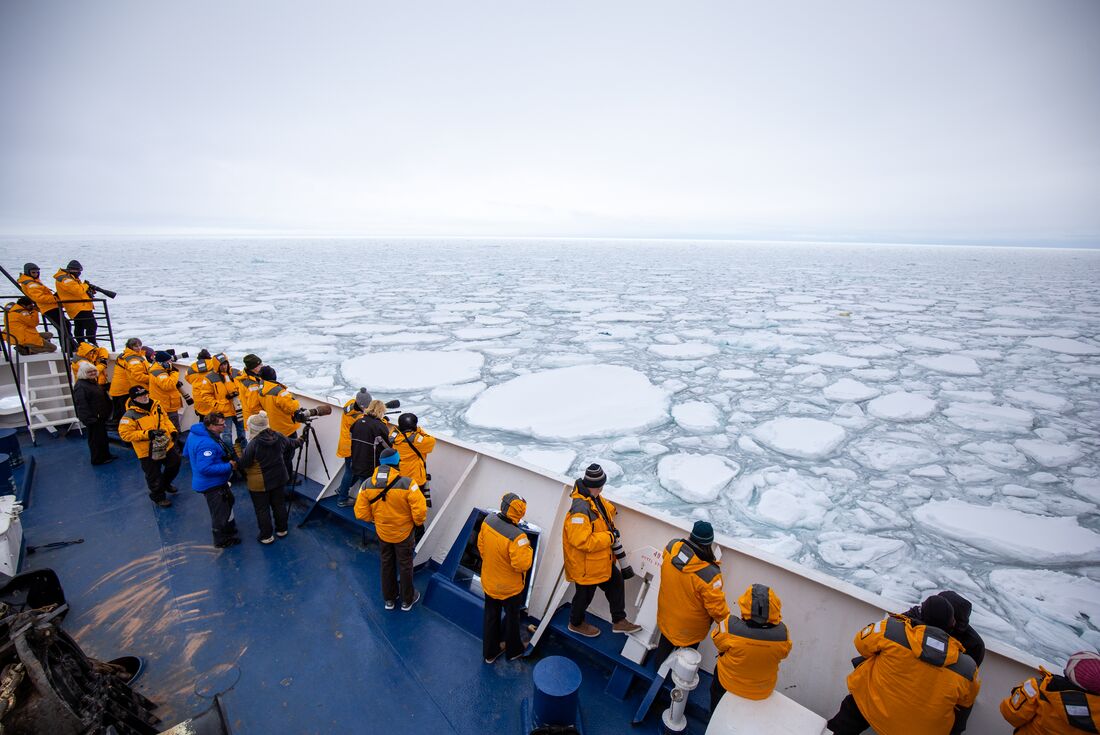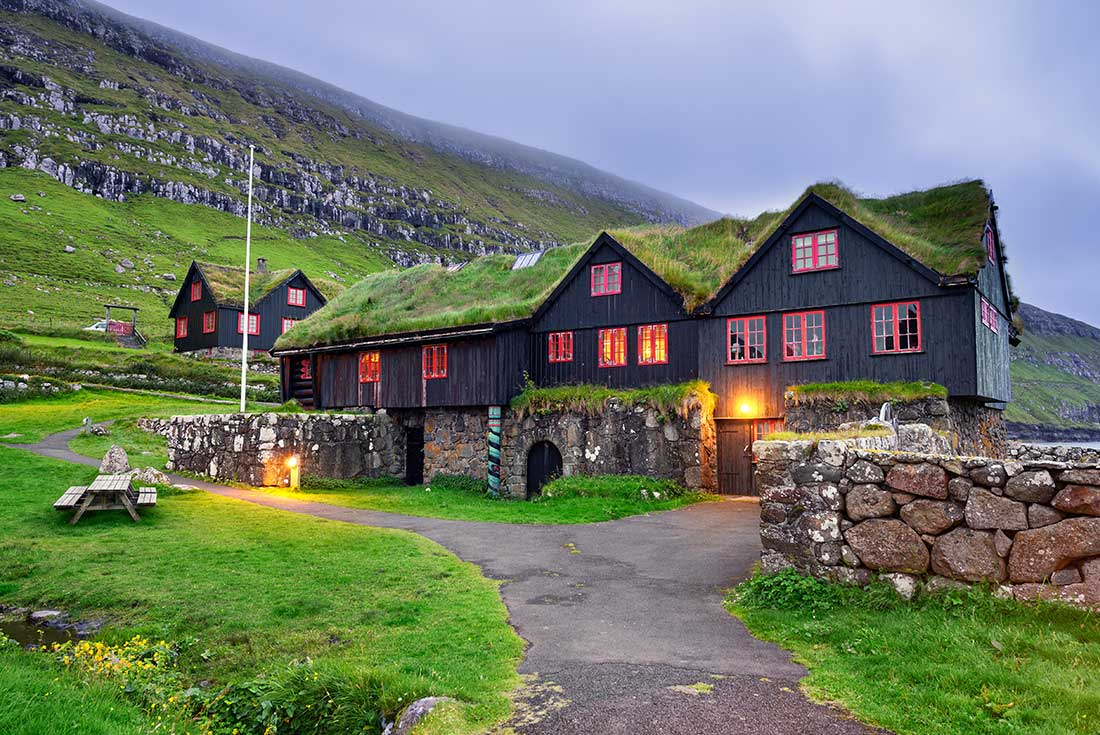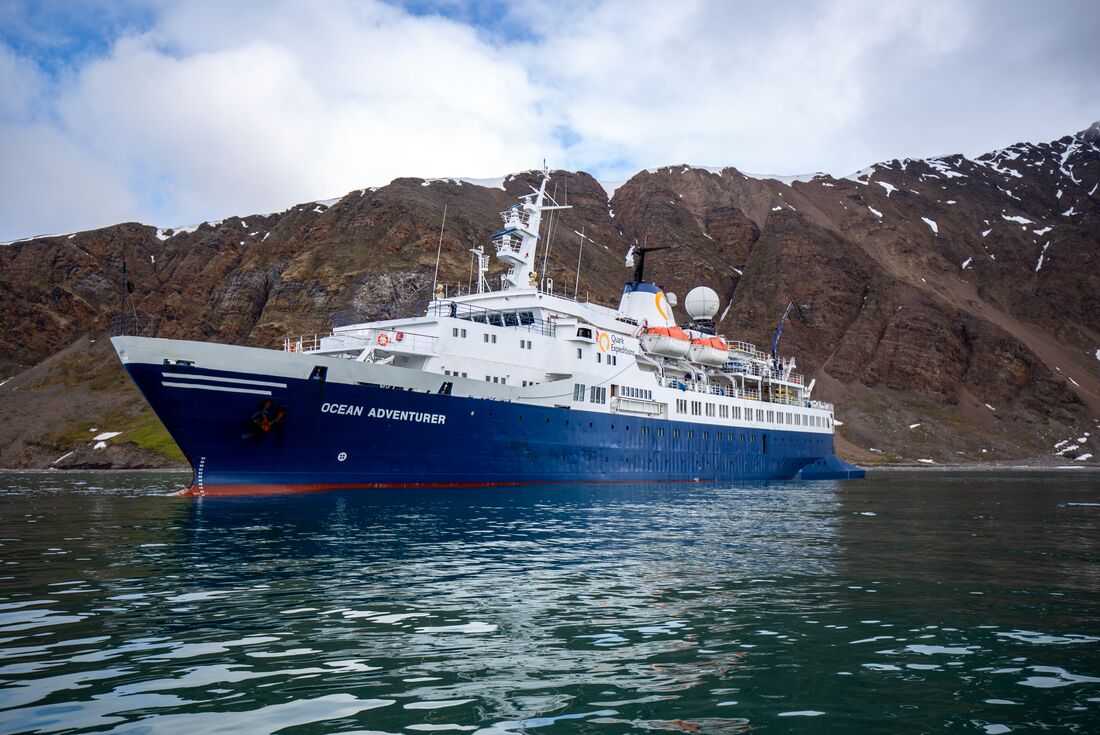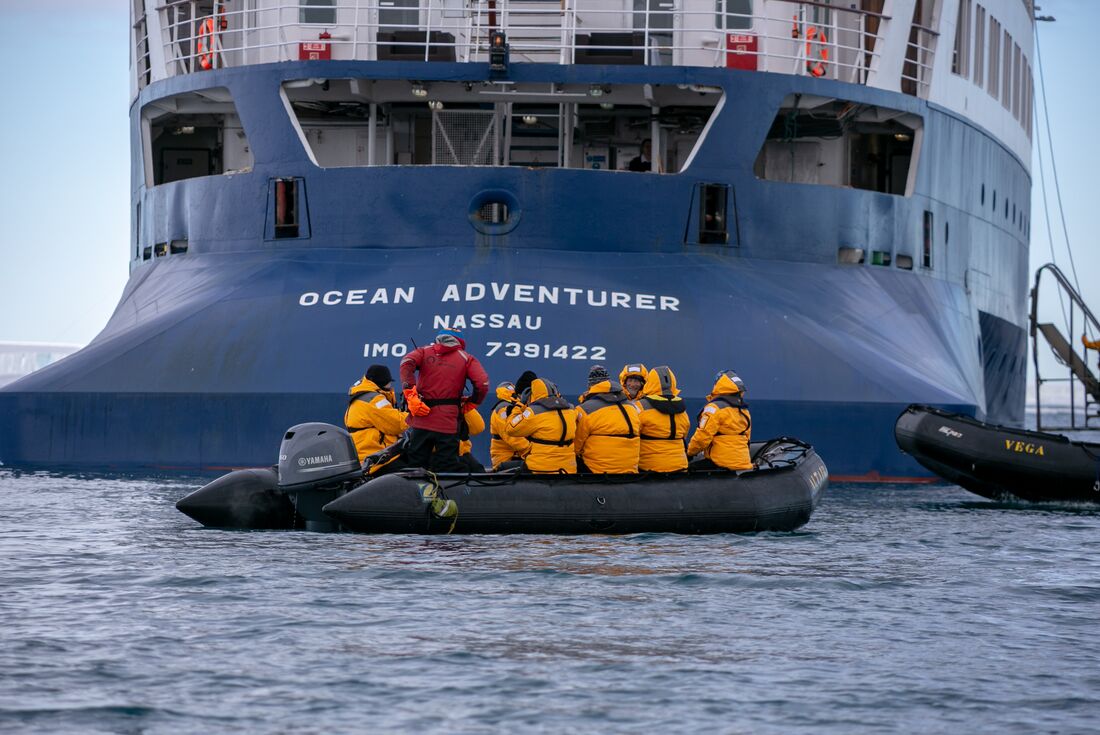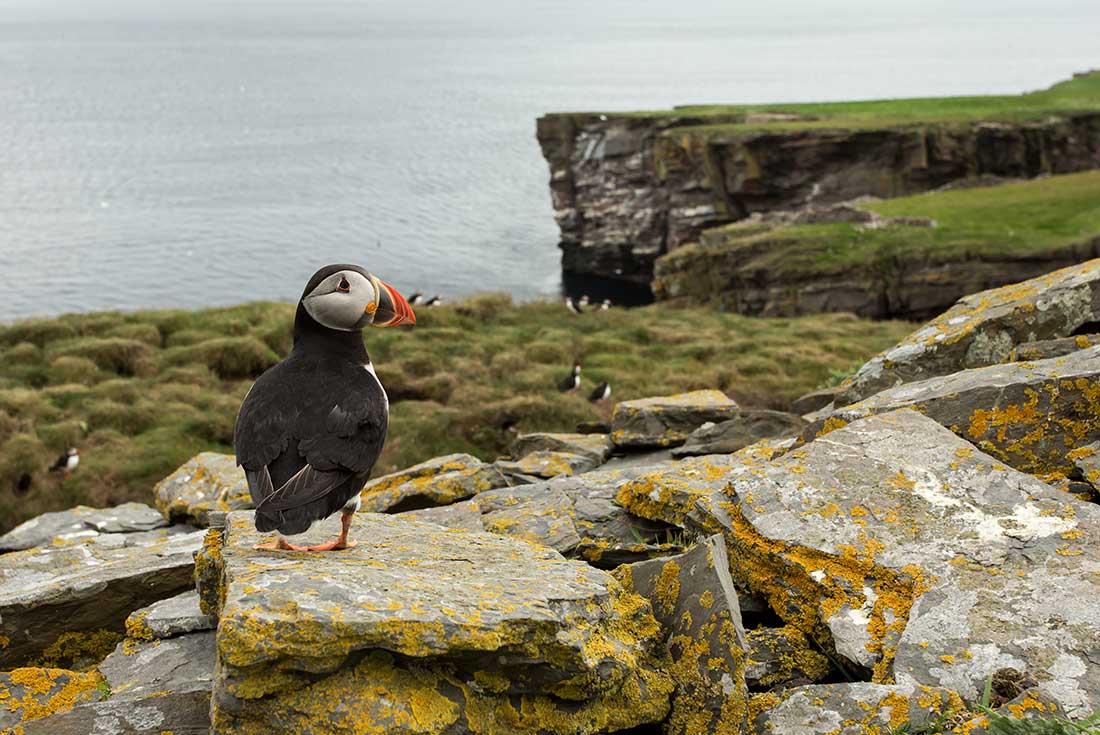- Spot puffins on Fair Isle, the United Kingdom’s most remote inhabited island.
- Explore the maze of narrow laneways in Torshavn’s Old Town.
- Experience the mountainous beauty of Jan Mayen.
- Search for Hornsund's abundant wildlife, including reindeer, auk and polar bears.
25 Aug 2021
Exploring Spitsbergen via the Faroes and Jan Mayen
PPSFJ
Validity: 17 May 2022 to 30 May 2022
Eerily beautiful, starkly secluded and richly interwoven with Norse myth, the Arctic territories of Scotland, Denmark and Spitsbergen stand as travel destinations both spectacular and captivating. In cruising from isle to inlet, fjord to fishing village, you'll develop a deep appreciation for the natural wonders of this ecosystem and for those who first chartered it. Travelling by expedition ship and exploring by Zodiac, you'll encounter Viking history on the Faroe Islands and grassy banks inhabited by comical puffins on Fair Isle, experience contemporary Scottish culture in Aberdeen and modern Nordic life in Alesund, be awed by Hornsund's and Lilliehook glaciers and the frontier town atmosphere of Longyearbyen.
Peregrine
Polar
Ship,Zodiac,Plane
2
Although you don't need to be particularly fit to take part in an Arctic expedition, you do need to have a good level of mobility. You must be able to complete the on board safety drills and emergency evacuation procedures unaided. Rolling seas and windy conditions require you to be stable on your feet while negotiating the ship over potentially slippery decks and gangways. The zodiacs are accessed via a gangway or stairs which may be steep on some ships. Some of our ships have lifts, but these may not access all decks so some stair climbing on board will be necessary.
Aberdeen
Aberdeen
UNITED KINGDOM
Oslo Airport
Oslo
NORWAY
BOOKING CONDITIONS Arctic and Antarctic bookings have an increased deposit requirement of 20% of the full voyage cost (before any discount). The balance is due 120 days before departure. If a booking is cancelled 120 days or more before departure - the cancellation fee is the full loss of the deposit paid. If a booking is cancelled between 119 days and departure - the cancellation fee is 100% of the total price of the voyage. Other fees may apply for air tickets and other arrangements booked in conjunction with a Polar voyage. Your voyage is operated by our sister company, Quark Expeditions. All accommodation and transfer arrangements as listed in the itinerary are also operated by Quark Expeditions or their local representatives. .
Your voyage will be led by an experienced Expedition Leader. In addition, a number of experts will be on board to add knowledge of their field to your experience. This will include a Marine Biologist, Ornithologist, Glaciologist or Geologist, Polar Historian, Kayaking guide and Naturalist guides. Voyages offering other adventure activities will have additional specialist guides on board.
Safety is paramount on a your voyage. Due to new International Security Regulations, you will not be able to approach the ship on your own. You will have to arrive with the rest of the group, accompanied by a Quark representative. Full details of embarkation/disembarkation procedures will be supplied with your final documentation. On board you will be asked to participate in the obligatory lifeboat drill. We will also conduct important briefings on landing procedures and Zodiac operations. Travelling in the Arctic, encounters with Polar Bears are not uncommon in some areas (and one of the best reasons to go there). You will be given a briefing on Polar Bear safety on board the ship before your first shore landing. Your guides will carry fire arms and bear deterrents on all excursions. Always follow the instructions of your guide while on shore. All ships operating in Polar waters must comply with a variety of regulations, codes and industry standards. All our ships adhere to regulations set by IMO (International Maritime Organisation) including ISM Code (Safety Management System), ISPS Code (for ship and port security), SOLAS (Safety of Life at Sea) and MARPOL (Maritime Pollution Prevention). In addition, Quark Expeditions is a full member of IAATO (International Association of Antarctic Tour Operators) and a full member of AECO (Association of Arctic Expedition Cruise Operators). Quark Expeditions have also been externally audited for its' health and safety programme and have been awarded the British Standard BS8848, the only expedition cruise company to have this accreditation.
All of our ships have facilities to communicate with the outside world. Satellite phone communications are available on all ships but be aware that on some ships, this connection is only available in certain locations and may not be possible from your cabin. Satellite communications can be intermittent and may not be available at all times or in all locations. Phone calls are charged per minute of usage. Internet access is possible via wifi on your personal laptop or device in certain areas of each ship and is charged via a pre-paid card which can be purchased through the hotel manager. Each ship also has a computer for passengers to use for internet access and emails and the hotel manager can set you up with a temporary webmail address. Please be aware, accessing some websites from the ship will be very expensive as downloading picture heavy content will use up a large amount of data. Text only emails use up much less data and is a very affordable way to communicate with friends and family at home. All communications from the ship are a bit intermittent as when travelling through mountainous areas or through narrow channels, signals can be disrupted and may not be transmitted until clearing this terrain or until satellites next pass overhead. Please make sure your loved ones have realistic expectations of your ability to communicate with them so they don’t worry about you.
PASSPORT You will need a valid passport to travel internationally. As a general rule, most countries require that your passport has a minimum of 6 months validity remaining. Your passport details are required to complete your booking. Please ensure the name on your passport matches the name on your booking and airline tickets exactly and contact us immediately if there are any errors. We recommend taking copies of the main passport pages and other important documents with you as well as leave copies at home with family or friends. VISAS Visas are the responsibility of the individual traveller. Entry requirements can change at any time. It is important that you check your government's foreign travel advisories along with the consular website of the country or countries you are travelling to for the most up to date information specific to your nationality and circumstances. Please be aware that not all visa information found online from other sources may be valid while COVID-19 restrictions are in place. Visas can take several weeks to process, so make sure you research the requirements as soon as you have booked your trip to allow for obtaining any necessary documents as well as the application and processing time. Your booking consultant can advise on a visa processing service or you can apply yourself directly through a consulate. COVID-19 Entry and Exit Requirements Below you will find general visa advice about the destinations on your trip. Due to constantly evolving COVID-19 requirements and restrictions, please refer to your government's foreign travel advice for the most up to date information.You may also refer to our travel alert page for more info https://www.intrepidtravel.com/en/travel-alerts Make sure you are familiar with the current border measures and entry requirements as these are quite complex and changing frequently without notice. Please also ensure you have a travel insurance policy that covers your travels as well as medical or COVID-19 related expenses within the country. RETURN TRAVEL Please ensure you stay up to date with any current testing or quarantine requirements for returning to your home country or transiting through other destinations after the completion of your tour. We are able to help facilitate taking a COVID-19 test while on trip. Please ensure you have funds available to cover the cost of this test which will be payable directly to the testing site. Your Intrepid Tour Leader will provide more details at the group meeting as well as assist with booking appointments for all travellers who need to be tested. As a general rule most countries expect that your passport has a minimum of 6 months validity remaining. Please ensure the name on your passport matches the name on your booking and airline tickets. Your passport details are required to complete your booking. Your consultant will contact you when this is required. Take a copy of the main passport pages and other important documents with you, and leave another copy at home with family or friends. NORWAY Visas are currently not required for Australian, New Zealand, US, Canadian or UK/EU passport holders wishing to visit Norway. Some EU nationals may travel in Europe using only an identity card, however it is your responsibility to check with the relevant authorities if this applies to you. Visas are currently not required for Australian, New Zealand, US, Canadian or EU passport holders wishing to visit the United Kingdom. Some EU nationals may travel in Europe using only an identity card, however it is your responsibility to check with the relevant authorities if this applies to you. The Faroe Islands visa conditions are similar to that of Denmark. If you require a visa for Denmark, then you will require one for the Faroe Islands. An application must be submitted to a Danish Embassy however the visa must specifically state that it is valid for the Faroe Islands. The Faroe Islands are not part of the Schengen group of countries so a Schengen visa is not sufficient to visit the Faroes.
Spot puffins on Fair Isle, the United Kingdom’s most remote inhabited island.
Explore the maze of narrow laneways in Torshavn’s Old Town.
Experience the mountainous beauty of Jan Mayen.
Search for Hornsund's abundant wildlife, including reindeer, auk and polar bears.
As you’d expect, temperatures in the Arctic are very cold. A warm parka will be provided along with waterproof boots and unlimited hot drinks, but you should also bring base layers and lots of warm clothing. Please see the Essential Trip Information for further important details about what to bring. Weather depending, you will be making regular excursions in a Zodiac boat to explore the local area and look for wildlife. It can get very cold and wet on the Zodiac, so make sure you are dressed appropriately and that you keep your camera safe and dry. Sturdy sea legs are needed as you make wet and dry landings from the boat, and on steep terrain, snow and other uneven surfaces. Some ships also have a lot of stairs. The weather plays a pivotal part in this adventure and although there’s an itinerary in place, there are no guarantees that you’ll be able to do everything that is planned for. A level of flexibility and openness to embracing the unexpected are important in expedition travel, especially to such a remote area. This trip takes places during the time of year that Spitsbergen enjoys 24-hour daylight. Just one of the benefits of this is that incredible wildlife can be seen at any time of the day – be prepared to be woken at any time so as to not miss out on exciting animal sightings. Polar bears are one of the most incredible and appealing animals on the planet, but they are also powerful predators with little fear of humans. Therefore, it’s necessary to be aware of the guidelines surrounding any contact with Polar bears. Follow your leader’s instructions and do not stray from your group.
Vaccination requirements do change, but generally you do not need vaccinations for this voyage but some may be required or recommended for countries you are visiting enroute to the Arctic. It is your responsibility to ensure that you obtain any vaccinations or preventative medicines for the countries you are visiting – or any which may be required by your home country upon your return. To find out which, if any, vaccinations are mandatory or recommended for your destination contact your local doctor, immunisation centre or medical centre for up-to-date information. You should be issued with an International Certificate of Vaccination booklet that records each vaccination. Always carry this with you on your travels; it could provide essential information for doctors in the event that you fall ill whilst travelling. MOTION SICKNESS Although our vessels are among the most stable ships in their class, we will still inevitably encounter motion. Unless you are certain you are impervious to the problem, you should take precautions against seasickness. Your doctor can advise you as to the best methods for avoiding this uncomfortable condition. There will be a licensed English-speaking physician on board. Your vessel will have a medical clinic with a limited supply of prescription medicines and basic first aid equipment. The clinic will not be stocked with every drug or piece of equipment required for every medical problem. If you are under regular treatment for any ailment, you must bring a sufficient supply of medicines for yourself. We cannot accept responsibility for not having a specific brand or type of drug on board. It is wise to carry an extra week’s supply of prescription medications just in case of flight delays or other unforeseen circumstances. If you have particular health needs, please bring with you a signed and dated letter from your physician explaining your health problems and/or the dosage required for the prescribed medication. The letter will assist our doctor on board, and any emergency medical personnel to care for you should you become ill. Please hand the letter to the expedition doctor once you are on board.
Breakfast, lunch and dinner are served in the dining room. Hours of operation will be posted and are subject to change to accommodate the expedition. Coffee, tea and cocoa are available around the clock. The tap water on board is safe to drink. We're able to meet most special dietary requests, as long as you have clearly indicated your requirements far in advance of your voyage. Kosher food cannot be prepared.
When it comes to money matters on the trip, every traveller is a little different. You know your spending habits better than we do, so please budget a sensible amount for things like meals not included, drinks, shopping, optional activities, tipping and laundry. It's always better to bring a little more than you think you'll need. Also make sure you've read your trip details thoroughly so you know what's included in the trip price and what isn't. this shoud make budgeting a little easier. You'll find this info in the Inclusions section of your Essential Trip Information (that's this document). MEALS NOT INCLUDED We recommend you allow US$100 per person for meals not included in the itinerary All services onboard your ship such as communication charges, laundry, and bar charges will be added to your onboard account and are charged in US dollars. Your account can be paid with US dollars cash, traveller’s cheques or by Visa or MasterCard. Outside of the start or end point of your expedition, cash will be of most use in the Arctic. In Svalbard, Greenland and the Canadian Arctic, credit cards are not readily accepted and ATM’s are virtually non-existent. On voyages that visit local towns and villages, there is the opportunity to buy souvenirs and some villages have thriving art scenes with local artisans selling their wares. In addition, some museums and sites charge entry fees and in some locations, you may wish to buy food and drink (although the meals on the ship are very good and plentiful). TIPPING The voyage fare does not include the customary, optional gratuity which is divided between the ships' crew, and hospitality staff. We suggest US$13 - US$15 per day as a guide. Any tip for the Expedition Team is extra to this and is at your discretion. Gratuities can be added to your onboard account at the end of the voyage or paid in cash on board. Full details will be provided before you settle your onboard account. SVALBARD Svalbard uses Norwegian Kroner as it's currency. Credit cards will be accepted in Longyearbyen but beyond the capital, cash in Norwegian Kroner will be required however, there are very few opportunities to spend money in Spitsbergen outside of Longyearbyen. The monetary unit is the British (£), divided into 100 pennies. FAROE ISLANDS Both Faroese Krona and Danish krone are usable in the Faroe Islands. The Faroe Islands print their own bank notes, but Danish coins are used for change. Credit cards can be used in most shops and restaurants and ATM's are located outside bank branches throughout the country.
The Arctic usually has - relatively - mild weather conditions in high summer. Temperatures below -5ºC are not common (although wind-chill factor can significantly add to the effect.) As a result, you should not need to make many expensive specialist gear purchases, although you do need good wet weather pants and you do need warm clothing. Wet weather jacket and boots are supplied on board the ship. On shore we do aim to provide hiking and walking opportunities whenever possible, so a reasonable pair of walking shoes or boots is suggested. The dress code on board is relaxed and casual; you will not need to dress formally for meals. The inside of the ship is well heated, so you will not require special clothing on board. Indeed, you could spend most of your time in light trousers and a t-shirt! However, it is not unusual for you to want to go out on deck suddenly - a whale sighting, or seals on a nearby ice-floe or hopefully a polar bear - nearly always produce a major exodus, so you need to keep warm clothing handy at all times, even when a shore excursion is not imminent. When you do go ashore you will require warm clothing - a few layers of light and medium-weight items which can be easily adjusted rather than one or two large and bulky items - and wet weather gear to protect you from the spray which can sometimes be encountered on the Zodiacs. Below is a list of equipment and documentation that we suggest you take with you. Please use this checklist as a guide when packing for your holiday. Laundry facilities are available on board the ship. Travel documents: passport, visa (if required), travel insurance, air tickets or e-ticket receipts, Trip Notes Photocopy of main passport pages, visa (if required), travel insurance and air tickets Spare passport photos Money: cash/credit card/EFTPOS card Money belt (for travelling en route) Small first-aid kit Ecologically friendly laundry soap Daypack (lightweight and waterproof) Watch/alarm clock and torch/flashlight (and spare batteries) Electrical adapter plug Toiletries/travel wipes Sunscreen, lip balm, moisturising cream, sunhat and sunglasses (with UV protection) Swimsuit (in case you wish to take the Polar Plunge) Earplugs and eye mask (for light sleepers) Extra pair of prescription glasses (if required) 2 strong plastic garbage bags (for laundry and in case of rain) Refillable water bottle Phrase book (if travelling en route to ship) Gloves (2 pairs minimum) Hat that covers ears Scarf or other face protection Wind and waterproof pants (a few sizes larger) Warm pants Comfortable shoes Long wool or cotton socks (for expeditions) Silk or polypropylene socks (for inside the ship) Jumpers/sweaters/fleeces Cotton turtlenecks and t-shirts Camera and spare film (or recharge for digital cameras) Plastic bags with zippers for carrying film, etc Binoculars Your prescritpion medication, seasickness medication and painkillers
After your travels, we want to hear from you! We realise that our partner company may ask you to complete paper or online feedback following your trip, however we would also like to know what you thought and encourage you to submit your feedback to us too. We rely on your feedback. We read it carefully. Feedback helps us understand what we are doing well and what we could be doing better. It allows us to make improvements for future travellers. https://bookings.peregrineadventures.com/bookings/en_AU/feedback/
For general enquiries or questions about your booking, please contact your agent or adventure specialist, or visit us at http://www.peregrineadventures.com/en-gb/contact-us In the case of a genuine crisis or emergency please contact our local ground representative on the number below. Quark Expeditions: +1 647 449 5303
Travelling responsibly is all about making good choices. It's about ensuring you have an incredible trip while also having a positive impact on the local environment, community and economy you're travelling in . How can you be a Responsible Traveller? See our tips below: * Choose to travel with a responsible travel company like us! We've already offset the main carbon emissions of your trip, so your footprint is already lighter. * Consider offsetting your flights too. * Bring a refillable water bottle and some water purification tablets (or a Steripen) to cut down on plastic bottle waste. * Be an animal-friendly traveller. Only go to venues that respect animals by allowing them to live normally in their natural environment. Steer clear of venues that use animals for entertainment or abnormal activities and/or keep animals in poor and unnatural conditions. * Eat at local restaurants, buy from regional artists and support social enterprises so you can contribute directly to locals and their economy. * Always be respectful of local customs and ask permission if you want to take a photo of someone. * Learn a few words of the local language and engage with the people around you. * Carry a cloth or re-usable bag so you can avoid plastic bags. * Give back by making a donation to a local project via The Intrepid Foundation. Share your thoughts with us by completing your feedback form after your trip. This helps us to continue to improve our commitment to responsible travel. As a member of the Association of Arctic Expedition Cruise Operators (AECO), Quark Expeditions are supporters of responsible tourism that mitigates the impact of our shore landings on the landscape or wildlife. Quark was the first operator to offer inclusive Carbon Neutral voyages on the Ocean Diamond. By doing so we have enhanced our commitment to ecological sensitivity and to minimising our impact on the areas we visit including: • Having our vessels burn Marine Gas Oil (MGO) a clean burning fuel with a low emission factor. • Conforming to all international regulations/policies governing disposal of waste at sea. • Serving only sustainable seafood. • Using only eco-friendly laundry chemicals and room amenities. • Removing disposable water bottles from the ships. • Making all our voyages virtually paperless by 2014 and having any paper used be 100% recyclable. AECO members also operate according to established rules of conduct, which, while you travel with us, we ask you to respect. A copy of the AECO guidelines will be provided prior to travel and staff will brief all passengers prior to the first landing.
Help us change thousands of lives by creating meaningful work and supporting skills training in communities around the world. The Intrepid Foundation is the not-for-profit for Peregrine Adventures, a brand of the Intrepid Group, and works with local organisations around the world to improve the livelihoods of vulnerable individuals and communities through sustainable travel experiences. With our travellers’ help, we’ve contributed more than AU $6 million to over 100 community organisations since 2002. Did you know that tourism is one of the biggest contributors to the global economy, making up 1 out of every 10 jobs? That’s why we support local projects that create meaningful jobs and give people the skills they need to work in the destinations we take you to. And it’s why we exist – to make it easy for travellers to give back to the communities and places they’ve been in an effective and meaningful way. Intrepid Group covers all administration costs, every cent goes directly to the projects. Donating is simple and secure. Please ask your leader for information about the projects we support through The Intrepid Foundation or visit our website:
Your voyage fare includes Emergency Evacuation Insurance to a maximum benefit of US$100,000 per person. However, it is essential that you have comprehensive personal travel insurance in addition to this to cover all other eventualities.
On your voyage, you will be travelling with up to 137 other people (depending on which ship you are on). The ships are spacious with ample deck space and public areas so it is always possible to find a spot to yourself to enjoy the scenery and some solitude. On excursions, you will travel in a zodiac with up to 10 guests on each boat. Polar travel attracts travellers of all nationalities and meeting people from other countries is one of the pleasures of life on board. The voyages will be conducted in English and clients who do not speak English will need to travel with someone able to translate for safety reasons. Some voyages may have large non English speaking groups travelling with translators so you may find that announcements are translated for their benefit and presentations may be given separately in their own language or translated. Single occupancy is available in most cabin categories for 1.7 or 2 times the twin berth price (dependent on which cabin category). Single travellers wishing to share will be matched with another solo traveller of the same sex. Please note that it is not possible to share with a stranger in all cabin types. Please speak to a consultant for full details.
Polar travel requires an amount of flexibility as weather, ice conditions and wildlife can all affect where your ship is able to access, and where your Expedition Team think you will get the best experience possible from your trip. On board, daily updates are given to advise what the specific itinerary will be for the next day based on local conditions. Published itineraries are subject to change when local conditions dictate.
Expedition cruise ship



